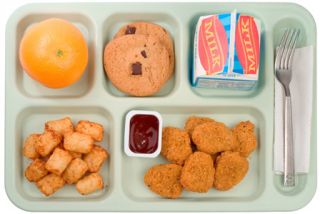Diet
Why School Lunch ISN’T Making Kids Fat
And What We Can Do to Change School Cafeteria Culture
Posted September 18, 2013

From “pink slime” in school meats to allowing pizza to count as a vegetable because of its tomato paste content, many school districts have faced the wrath of angry parents over what their children are being served for lunch. In response to this call for action, approximately 94% of public schools have begun participating in the National School Lunch Program, which is designed to provide healthy, low-cost breakfasts and lunches through the 2010 Healthy Hunger-Free Kids Act.
But the situation is still looking bleak. One in three children is suffering from obesity. Further, many children (and some parents) are not fond of the new foods in this program, and some claim that they are not being offered enough calories for their growing bodies. Some schools have even reported switching back to their unhealthy menus due to the waste factor: if students won’t eat the healthy options, this food ends up in the garbage can.
Why is it that the change from 800-calorie Sloppy Joes to whole grains and bigger portions of fruits and vegetables hasn’t made a significant difference? Here is what I think: we abruptly changed the foods and didn’t consider the psychological aspects of eating. For example, if you offer someone a new food when they are accustomed to eating something more desirable, the newer, less desirable food may seem even worse than it would if it was offered in a different context. This is a concept known as negative contrast. Of course low-fat cheese and whole wheat pizza tastes bad when you are used to eating the full-fat version. If changes were made subtly and over time, this effect may not be as pronounced.
We also need to consider the reward value of the foods that kids like to eat. A study called “The State of Nutrition and Physical Activity in Our Schools” found that oil-cooked French Fries were so popular at many schools that some students bought lunches for the fries only, throwing everything else away. When left to make their own decisions about what to eat, most kids will opt for the foods that they find most rewarding, not most nutritious. Furthermore, many children not only pass on healthy lunch food, but they indulge in alternative foods offered by their school: ice creams, chips and other snacks. On a typical school day, approximately 47 percent of middle school students and 57 percent of high school students will purchase these types of alternative foods from vending machines or other outside sources.
So what can we do? Below are 5 tips parents can try to help their kids have a healthy school lunch:
1. Find out what is on the menu. Ask your school to give you a list of what is served and go over it with your child. This way, you can help them to understand what are good vs. poor choices. You can also learn about your child’s food preferences and help to offer alternatives if they like something on the menu that is less than ideal. It is also an opportunity to teach them about having a small portion of something that may be very tasty but less healthy. Show them appropriate sizes (e.g., a “few” tater-tots is not 20).
2. Bring lunch from home some days. Buying lunch is a convenience for parents and can be fun for kids (especially younger ones who are starting to feel their independence), but if you mix it with lunches from home, then it won’t become a habit. Plus, you will have more control over what your child is eating.
3. Don’t give ice cream money. I have heard from many parents that they give their children money to buy ice cream or other snacks at school because they want them to fit in with other kids. Stop it! I find it hard to believe that the social hierarchy of schools is based off of whether or not you eat ice cream. And if it is, then this certainly isn’t something that we as parents should be promoting. Dessert-after-lunch is unnecessary, especially if they are going to get sweets after school or at home. If you give your child money to get a “treat” after they eat their lunch, there is also a chance your child may be throwing their lunch in the garbage and eating ice cream instead.
4. Set a good example. When some students were asked why they wouldn’t eat the foods that the school provided for them, one of the main complaints was that they weren’t used to eating that kind of food. As parents, we expect our schools to provide children with the best education and nutrition. Schools can offer the healthiest food options available, but students may not benefit if education about healthy eating does not begin in the home. Children will most likely not eat an adequate serving of fruits and vegetables at school if they’re not encouraged to at home. Being a role model for what and how to eat and serving our children a variety of nutritious foods may be the most powerful and effective steps in our fight against childhood obesity.
5. Teach kids why it is important to eat a healthy lunch. If your child is lean or overweight, they should still understand the importance of eating a healthy lunch. People are probably more likely to initiate and maintain a behavioral change when they understand the cause-and-effect associated with the behavior as opposed to being told “because you have to.” In an age-appropriate way, you can teach your children about the consequences and dangers of eating an unhealthy diet. The conversation isn’t about becoming “fat,” but rather it is about being healthy to avoid having to go to the doctor, visit the hospital, take yucky medicine, etc. You can also describe the benefits of eating nutritiously such as more energy for sports and extracurricular activities.
Dr. Nicole Avena is a research neuroscientist/psychologist and expert in the fields of nutrition, diet and addiction. She has published over 60 scholarly journal articles, as well as several book chapters on topics related to food, addiction, obesity and eating disorders. She recently edited the book, Animal Models of Eating Disorders (Springer/Humana Press, 2013), and she has a book Why Diets Fail (Ten Speed/Crown) available for preorder now and to be released in January, 2014. Her research achievements have been honored by awards from several groups including the New York Academy of Sciences, the American Psychological Association, the National Institute on Drug Abuse, and her research has been funded by the National Institutes of Health (NIH) and National Eating Disorders Association.
Website:http://www.drnicoleavena.com/
Twitter: https://twitter.com/DrNicoleAvena




